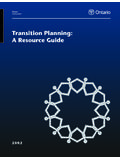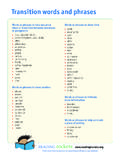Transcription of Texas Transition and Employment Guide
1 Texas Transition and Employment Guide 2 Sections of the Transition and Employment Guide About This Guide Self-Advocacy, Person-Directed Planning, and Self-Determination Page 3 Introduction Page 4 Timeline Page 5 Who Can Help Page 6 Transition Services Introduction Page 9 Timeline Page 11 Who Can Help Page 11 Employment and Supported Employment Services Introduction Page 14 Timeline Page 16 Who Can Help Page 17 Social Security Programs Introduction Page 19 Timeline Page 20 Who Can Help Page 20 Community and Long-Term Services and Supports Introduction Page 22 Timeline Page 23 Who Can Help Page 24 Postsecondary Educational Programs and Services Introduction Page 27 Timeline Page 28 Who Can Help Page 29 Information Sharing with Health and Human Services Agencies and Providers Introduction Page 33 Timeline Page 34 Who
2 Can Help Page 35 Guardianship and Alternatives to Guardianship Introduction Page 36 Timeline Page 38 Who Can Help Page 39 Contact Information f or All Relevant State Agencies Page 41 Texas Transition and Employment Guide Definitions Page 42 Federal and State Laws Page 48 Transition in Texas Ti meli ne Page 51 3 ABOUT THIS Guide This Transition and Employment Guide is for you, the student in Texas public school, who may have received special educati on services due to a disability. It also provides helpf ul informati on for your parents. This Guide has steps you and your parents can take to make sure y ou are able to find t he right work or educational choices for y ou after high school.
3 I t also tells you where to get t he services y ou will need after high school. The Guide is divided into sections on Self Advocacy, Transiti on Services, Employment and Supported Employment , Social Security Programs, Community and Long Term Servi ces and Supports, Postsecondary Educational Programs and Services, Information Sharing, and Guardianship and Alternati ves. E ach section has phone numbers, emails, and websites to help you find what you need. At the end of each section and at the end of the Guide , you will fi nd a timeline of steps that you and your parents can take as you make the Transition fr om student to adult. If you have questions about this Guide or t he informati on in it, please send us an email at Copyright Notice These materials are copyrighted by and are the property of Education Service Center, Region 11 and the Texas Education Agency and may not be reproduced, distributed or modified without their written permission except by Texas public school educators under the following conditions: 1.
4 Any portion reproduced or distributed will be used exclusively for nonprofit educational purposes in Texas and 2. no monetary charge is made for the reproduced materials, any documents containing them, or any activity at which they are distributed; however, a reasonable charge to cover only the cost of reproduction and distribution may be charged. To obtain a license to reprint large quantities, or to use the materials in a manner not specified above, contact or 4 SELF-ADVOCACY, PERSON-DIRECTED PLANNING, AND SELF-DETERMINATION INTRODUCTION Transiti on is the term used for the time when you are changing fr om a student to an adult. You, your parents, and your school begin to plan fo r Transition while you are st ill a student.
5 Your parents and the school need to understand your wants and needs to make sure they are included in your plan. Y ou need to talk to your parents and your teachers about how you can be come more involved in making decisions about your educational program and your plans for the futur e. When you turn 18, the law considers you an adult who has the rights and responsibiliti es of ev ery other adult. Y ou can still ask your parents for h elp to make important decisions. Before graduating fr om high school, y ou and your parents need to talk about many things. S ome of these things are getting a job, going to college, and where to liv e. Y ou can take a bigger part in making decisions for yourself by: learning how to speak up for yourself learning how to set goals worki ng on steps to reach your goals making choices as a young adult speaking up in your meetings helpi ng to plan your future This first section of the Texas Transition and Employment Guide talks about three ways for y ou to begin to plan fo r the future.
6 Self-Advocacy Speaking for Yourself Self-advocacy means speaking up for yourself. Y ou should ask for what you need and want when making life decisions. Knowing yourself is your fir st st ep toward being a self-advocat e. This means: talking about your needs, inter ests, likes, and dislikes knowing what you are good at and how y ou learn knowing what you want to do knowing what you have to do understanding your disability and how it affects your ability to work, learn, and live thinking about what you need to work, learn, and live learning your rig hts, responsibilities, and how to get help te lling people what you need and want asking for help asking questions when you do not understand something speaking up in your admission, review, and dismissal (ARD) committee and other planning meetings helpi ng to write your individualized educati on program (I EP)
7 5 Self Determination Choosing for Yourself/Making Your Own Choices Self-determination means making choices based on your needs and interests. You have the ability to learn and benefit fr om making your own choices. Making your own choices means: making decisions taking responsib ility for the decisions you make setting goals learning independent living, risk-taking, and safety skills believing i n yourself and your abilities solving problems speaking up f or yourself understanding what you know how to do and what you need t o learn dir ecting or leading your own life Person-Direct ed Planning You can begin to make your own choices about things that affect your life.
8 P erson-directed planning gives you the power t o direct the supports and servi ces that meet your needs. Y ou an d the people who know and care about you work together to make life ch oices. Person-directed planning is a pr ocess that allows you and the legally authorized representati ve (L AR) on your side, to direct the development of a plan of supports and services that meets your personal out comes. The process must: identi fy existing supports and services necessary to achieve your outcomes identi fy natural supports available to you and work out servi ce system supports you will need occur with the support of a group of people chosen by y ou and the LAR on your side accommodate your style of communication and preferences regarding time and setting for t he planning meeting TIMELINE When or before y ou turn 14: Speak up for yourself.
9 Talk about your interests, wants, and needs. Explain your disability and what you may need to help you be on your own. Participate in your ARD commi ttee meeting. When or before y ou turn 16: Talk about your goals f or life aft er high school. Pr actice how to act in diff erent places (school, jobs, and so on). Identify heath car e needs and providers (doctors, therapists, pharmacies) to meet your needs. When or before y ou turn 18: Plan for w orking, voti ng, further education, and signing up for services. Decide where you want to liv e and how y ou will do it. 6 Ask for help, say what you need, and tell peo ple that you know how to make decisions.
10 Be on time for cl asses, appointments, social activities, and work. Ask about other servi ces like health, Employment , counseling, techn ology, and housing that you can receive aft er hi gh school. Accept responsibili ty for health care needs (make doctor or therapy appointments, fill and take your prescri pti ons, etc.). Aft er graduation: Take over making choices for your life. Fi nd people who are willing to help you. Be open to tryi ng positive new things. WHO CAN HELP Local School Your school dis trict has a Transition and Employment designee (TED) to help you and your parents with informati on about being able to make life choices for yourself. Y ou can find information about your school s TED at : http: ?






